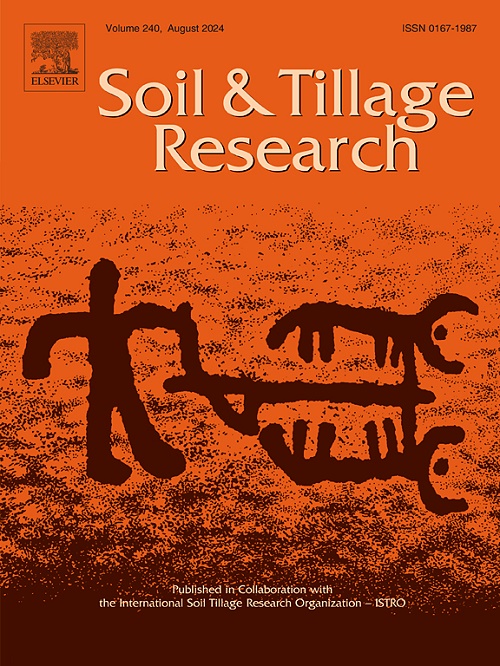黑麦免耕与混作覆盖作物对半干旱棉花灌溉系统土壤水氮动态及土壤固碳的影响
IF 6.1
1区 农林科学
Q1 SOIL SCIENCE
引用次数: 0
摘要
阿马里洛细砂壤土是德克萨斯州南部高平原(SHP)的基准土壤系列,该地区以广泛生产棉花(棉)而闻名。其粗糙的质地影响了土壤保持土壤有机碳(SOC)和水分储存的能力,而半干旱的气候条件和缺乏地膜覆盖来保护土壤免受风蚀,使其更加复杂。因此,建议采用减少/免耕(NT)和覆盖种植等土壤保持措施来固存有机碳,增加储水量,降低对风蚀的易感性。本研究的目的是利用反硝化-分解(DNDC)模型,评价覆盖作物的NT对SHP棉花生产系统的长期(1991-2020)影响。来自美国德克萨斯州Lamesa附近SHP区域实验站的现场数据(2014-2020年)用于模型校准和验证。田间试验包括常规不覆盖作物(CT)、黑麦免耕覆盖(R-NT)和黑麦、毛豆、萝卜和冬豆混合覆盖免耕(M-NT) 3个处理。在校正和验证期间,模拟和实测值之间的平均百分比误差(PE)分别为2.1 %和−4.4 %,模拟和实测值之间的平均百分比误差(PE)分别为4.5 %和−8.8 %。30年长期模拟结果表明,与CT相比,R-NT和M-NT平均增加了土壤有机碳40.2% %和59.2% %,总氮(TN)分别增加了22.6% %和25.8% %。与连作相比,覆盖作物处理在产量和土壤水分方面的变化更大。总体而言,本研究结果强调了覆盖作物和NT在半干旱SHP棉花生产系统中对土壤固碳和全氮的潜在益处,而不会对籽棉产量产生负面影响。本文章由计算机程序翻译,如有差异,请以英文原文为准。
Assessing the effects of no-tillage with rye and mixed cover crops on soil water and nitrogen dynamics and soil carbon sequestration in semi-arid irrigated cotton production systems
Amarillo fine sandy loam is a benchmark soil series in the Southern High Plains (SHP) of Texas, a region known for extensive cotton (Gossypium hirsutum L.) production. Its coarse texture affects the soil’s ability to maintain soil organic carbon (SOC) and water storage, which is compounded by the semi-arid climatic conditions and lack of mulch cover to protect the soil from wind erosion. Soil conservation practices such as reduced/no-tillage (NT) and cover cropping are therefore recommended to sequester SOC, increase water storage, and reduce susceptibility to wind erosion. The objective of this study was to evaluate the long-term (1991–2020) effects of NT with cover crops on SHP cotton production systems using the DeNitrification-DeComposition (DNDC) model. Field data (2014–2020) from an experimental site near Lamesa, TX, USA, in the SHP region was used for model calibration and validation. The field experiment included three treatments: conventional tillage without a cover crop (CT, as control), no-till with rye (Secale cereale L.) cover (R-NT), and no-till with mixed cover (M-NT) including rye, hairy vetch (Vicia villosa Roth), radish (Raphanus sativus L.), and winter pea (Pisum sativum L.). The average percent error (PE) between the simulated and measured seed cotton yield was 2.1 % and −4.4 %, and 4.5 % and −8.8 % between the simulated and measured aboveground rye biomass during the calibration and validation, respectively. The 30-year long-term simulations showed that, on average, R-NT and M-NT increased SOC by 40.2 % and 59.2 %, and total nitrogen (TN) by 22.6 % and 25.8 %, respectively, compared to CT. Greater variability in yield and soil water was found under cover crop treatments compared to CT. Overall, the results from this study highlight the potential benefits of cover crops and NT on soil carbon sequestration and TN in semi-arid cotton production systems of the SHP without negatively affecting seed cotton yield.
求助全文
通过发布文献求助,成功后即可免费获取论文全文。
去求助
来源期刊

Soil & Tillage Research
农林科学-土壤科学
CiteScore
13.00
自引率
6.20%
发文量
266
审稿时长
5 months
期刊介绍:
Soil & Tillage Research examines the physical, chemical and biological changes in the soil caused by tillage and field traffic. Manuscripts will be considered on aspects of soil science, physics, technology, mechanization and applied engineering for a sustainable balance among productivity, environmental quality and profitability. The following are examples of suitable topics within the scope of the journal of Soil and Tillage Research:
The agricultural and biosystems engineering associated with tillage (including no-tillage, reduced-tillage and direct drilling), irrigation and drainage, crops and crop rotations, fertilization, rehabilitation of mine spoils and processes used to modify soils. Soil change effects on establishment and yield of crops, growth of plants and roots, structure and erosion of soil, cycling of carbon and nutrients, greenhouse gas emissions, leaching, runoff and other processes that affect environmental quality. Characterization or modeling of tillage and field traffic responses, soil, climate, or topographic effects, soil deformation processes, tillage tools, traction devices, energy requirements, economics, surface and subsurface water quality effects, tillage effects on weed, pest and disease control, and their interactions.
 求助内容:
求助内容: 应助结果提醒方式:
应助结果提醒方式:


